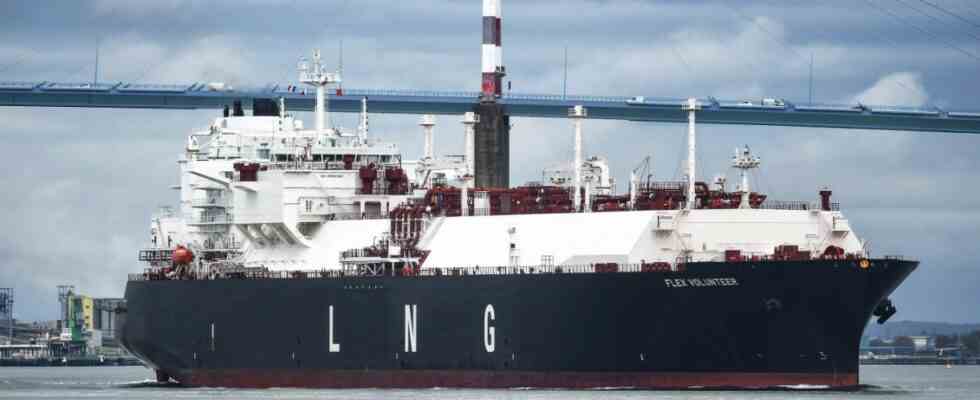The dispute is about a construction project worth ten billion euros, the future of Europe’s gas supply – and the protection of endangered beluga whales and the world’s climate: Investors want to build a terminal for shipping liquefied natural gas on Canada’s Atlantic coast, in French-speaking Québec , along with a 780-kilometer pipeline inland to connect the plant to the pipeline network. Siemens Energy is to supply important technology, but the Canadian federal government and that of the province of Québec rejected the project due to concerns about the climate and the environment only recently off. But then Russia’s troops invaded Ukraine, and now the EU is desperately looking for new gas suppliers.
Jim Illich is therefore confident that the authorities will reconsider their decision and even grant accelerated approval for the terminal and pipeline. The founder and main shareholder of GNL Québec, the project company, says in an interview with the SZ, the war has “dramatically changed the context for this decision: the Europeans want LNG as soon as possible, and Canada’s government has said it is looking at ways in which it can help its transatlantic allies.” In addition, be Energy Saguenayas the project is called, the most climate-friendly liquefied natural gas plant in the world.
If the authorities give the green light, construction work could start as early as the end of the year; the first tankers with the cooled and liquefied natural gas are scheduled to set sail for Europe in 2027. By this year, the EU should also completely independent of energy imports from Russia. Commission chief Ursula von der Leyen sets this goal.
So far, there are no terminals on Canada’s Atlantic coast to ship LNG – that’s the common abbreviation for liquefied natural gas. Just on the Pacific coast a port facility is being built, which is convenient for Asian customers, but not for European ones. But Canada’s government wants to support the EU in bidding farewell to Russian gas; this was a topic of talks with Prime Minister Justin Trudeau with von der Leyen as well as with the Federal Chancellor Olaf Scholz.
The “world’s greenest pipeline and the greenest terminal” are planned
GNL Quebec founder Illich was on a nine-day promotional tour in Europe last week. The US industry veteran spoke to government officials and potential buyers. The interest in his project is “incredible,” says Illich. He assumes that European governments would also express their enthusiasm to the Canadian government.
Trudeau’s government must then decide whether and how the project can be approved after the original rejection. One of main reasons The reason for the rejection was the authorities’ fear that the export of Canadian natural gas would increase greenhouse gas emissions in the destination countries. However, this concern is now obsolete, says Illich: The Europeans definitely want to import much more LNG as a replacement for Russian gas. And “if we are not allowed to build our terminal, another terminal will be built in Qatar, Australia or the US Gulf Coast,” argues Illich. “But they have a much worse climate balance than we do.”
The manager says he wants the “world’s greenest pipeline and that greenest LNG terminalThe liquefaction plant and the compressors for the pipeline would be powered by hydroelectric power, of which there are more than enough in Quebec. Other LNG terminals, on the other hand, would burn gas to generate the necessary energy. Moreover, it is in Quebec Much cooler than on the US Gulf Coast or even in Qatar – this makes it easier to liquefy the natural gas, adds the engineer.The sea route to Europe is also 40 percent shorter compared to terminals on the Gulf Coast, which saves fuel and gas production The environmental standards in Canada are very strict, which is why Illich calculates that the production and transport of liquefied natural gas from Québec is three to four times less harmful to the climate than corresponding supplies from the USA, Australia, Qatar or Nigeria.
In winter, Quebec’s Saint Lawrence River can freeze over.
(Photo: Philippe Renault/mauritius images)
Besides feared authorities that the noise from the tankers could disturb threatened white whales or belugas in the St. Lawrence River, the body of water at the proposed site. Illich says, however, that the project envisages “innovative protective measures” and that the additional traffic will not even amount to one ship per day on average over the year.
Eco-hydrogen is to be supplied in the future
The terminal could export 15 billion cubic meters of gas per year, which corresponds to a sixth of Germany’s annual consumption. In addition to natural gas, the plant could also load green hydrogen onto tankers – that is hydrogen that was obtained from water with the help of green electricity in so-called electrolysers. Illich wants to use Québec’s abundant potential for electricity from wind and hydropower to produce hydrogen in electrolysers for Europe in the future. It could gradually replace LNG exports.
Because the EU only needs LNG on a transitional basis – in the future, Europe should be able to get by without natural gas, for the sake of climate protection. At the same time, the need for climate-friendly manufactured hydrogen rise rapidly: for example to replace coke and coal in steel mills or to power trucks. “Green hydrogen imported from Québec will undoubtedly be able to compete in price with green hydrogen produced in the EU,” says Illich.
Especially since the EU will not be able to quickly increase its own production capacities for green hydrogen anyway. The CDU MEP Markus Pieper warns that there will not be enough green electricity available “even with rapid expansion”. Therefore, the EU urgently needs to find not only supplier countries for LNG, but also for hydrogen. “And for both we need politically stable trading partners, and we must not make ourselves too dependent on a small group of suppliers,” warns the industrial politician. There is no doubt that the project on Canada’s Atlantic coast would come in handy.

